Getting your Trinity Audio player ready...
“By the time you receive these lines, we three have resolved the problem in another way – in the way that you have constantly tried to dissuade us from [...] What has happened against the Jews in recent months arouses well-founded fear that we will no longer be allowed to experience a bearable situation”
These are the opening words of a letter by German-Jewish mathematician Felix Hausdorff to his friend, lawyer Hans Wollstein, after he had received orders to report to a concentration camp near the city of Bonn at the beginning of 1942. Hausdorf, who was 73 years old, had no illusions regarding the nature of this camp and had no intention of letting the Nazis murder him. He ended his own life, alongside his wife and her sister.
This marked the tragic conclusion of the remarkable career of one of the most significant mathematicians of the 20th century. Even today, more than eighty years following his death, Hausdorff’s contributions continue to serve as an important foundation for many branches of mathematics.
7 View gallery


The beginning of the letter sent by Hausdorff to his friend a day before he, along with his wife and sister-in-law, tragically ended their lives
(Photo: Wikipedia)
Between Art and Science
Felix Hausdorff was born on November 8th, 1868, in the German city of Breslau (currently Wroclaw, Poland). His father Louis was a businessman who mainly worked in textiles but was also a scholar and educated man, ordained at the age of 14 to teach the Torah, and later published articles in this field and was active in the German Jewish community. His mother Hedwig (or Johanna, according to some records) came from the wealthy Tietz family, who owned a chain of department stores. When he was two years old, his family moved to Leipzig due to his father’s business endeavors, and it was there that Felix was raised and educated.
As a student, Hausdorff excelled in many fields. The high school he attended placed significant emphasis on the study of ancient languages, and for his final exam, he had to compose an essay in Latin on the positions of the Roman statesman Cicero. He also wrote poetry in German and Latin and was often asked to recite his poetry at school events.
He excelled in mathematics and philosophy, and was especially noted for his musical talent as a gifted pianist. A friend of the family later recounted that upon graduating from high school, he contemplated whether to study music at the academy and aspire to a composer’s career, but eventually he yielded to the pressure exerted by his father and chose science.
In 1887 Hausdorff began his studies in mathematics at the University of Leipzig. Alongside his official courses, he also took courses in a huge variety of fields, including physics, chemistry, literature, philosophy, history, languages and more. He never abandoned his former love for music and also attended lectures on the history of music. He developed a strong affinity and great fondness for the music of Richard Wagner, who, ironically, later became one of the favorite composers of the high officials of the Nazi regime.
Once he graduated Hausdorff continued his studies, pursuing a doctorate in astronomy, under the guidance of Heinrich Bruns. His work was primarily mathematical, focusing on the examination of aspects of light diffraction in the atmosphere. Bruns used calculation of light diffraction data for analyzing the composition of Earth’s atmosphere, applicable to astronomical observations. However, it became clear that this method was not practical for observations, and soon after, alternative methods for direct sampling of the atmosphere using balloons were developed, rendering work in this field a dead end. Nevertheless, Hausdorff’s outstanding mathematics stood out in its own right, earning him a PhD in 1895, at the age of 27, and producing three scientific articles, which paved the way for his appointment as a mathematics lecturer at the University of Leipzig.
7 View gallery
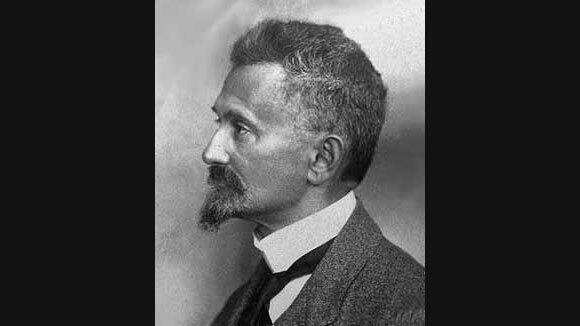

A gifted pianist, philosopher, poet and a doctor of mathematics at the age of 27. Felix Hausdorff
(Photo: Wikipedia)
A Double Life
During that period, alongside his mathematical work, Hausdorff was also focused on literary and philosophical writing. His publications included a poetry book, a play, a book about the philosophy of Persian cleric Zarathustra and a book of aphorisms - short, memorable phrases. In this book he first used the pen name Paul Mongré, which would accompany him for many years in his philosophical writings.
This symbolic name, derived from the French term “a mon gré”, meaning “in my opinion”, expresses Hausdorff’s independence and his choice not to limit himself to mathematics, and perhaps also his emancipation from the shadow of his father, who passed away in 1896. In total Huasdorff published 22 books in prose, poetry and philosophy, 17 of them during his most productive period, between 1897 and 1904.
”As a son of a wealthy family, he did not have to worry about advancing his career as a mathematician. For him, mathematics, both as a field of research and as a teaching subject, was more of a hobby than anything else,” wrote mathematical historian Sanford L. Segal about Hausdorff in his book on Mathematicians Under The Nazis.
In 1899 Hausdorff married Charlotte (Lotta) Goldschmidt, the daughter of a wealthy Jewish doctor and granddaughter of a female educator who was one of the pioneers of the feminist movement. A year later their only daughter Lenore (Nora) was born. In 1901 his appointment as associate professor at Leipzig University was approved.
Alongside his warm recommendations, the dean added: “The faculty considers itself, however, duty bound to inform the Royal Ministry that the present proposal was not approved by all members in the meeting on the 2nd of November this year, but rather by a vote of 22 to 7. The minority who voted against Dr. Hausdorff did so because he is of the Jewish faith.”
The results of the vote and the dean’s amendatory remark illustrate the overt antisemitism that prevailed in Leipzig at the time. Despite this, Hausdorff chose to stay there, and in 1902 he turned down an offer to become a professor at the University of Göttingen, one of the world’s leading centers in the field of mathematics. His decision was likely influenced by his many pursuits outside of mathematics. His social circle included mainly artists and philosophers, not scientists.
7 View gallery
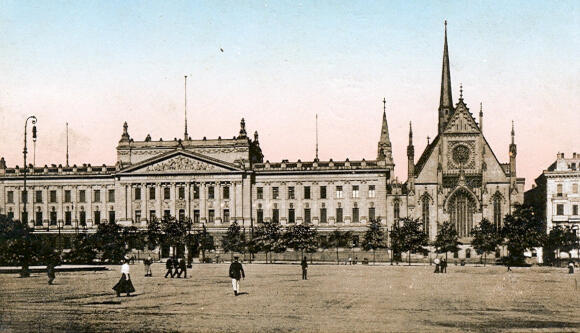

Overt antisemitism. The main building of Leipzig University in 1917, a few years after Hausdorff’s move to Bonn
(Photo: Wikipedia)
A Jew’s Profession
Undeterred by the turmoil of the time and his many other occupations, these were very productive years for Hausdorff in the field of mathematics. His research spanned a broad spectrum of fields, including optics, non-Euclidean geometry, hypercomplex numbers, probability, and even the mathematics of insurance.
In his 1897 paper on insurance, Hausdorff introduced a new method for estimating the risk that an insurance company assumes (variance of loss), which is used by insurance companies today in certain types of policies. His involvement in insurance also stemmed from antisemitism: according to Moriz Epple in a chapter dedicated to Hausdorff in the book Jews and Sciences in German Contexts, they university assigned him with teaching a course on the subject of the mathematics of insurance, claiming that it was a Jewish profession.
In the early 20th century Hausdorff’s mathematical focus began to converge more and more on one main topic: set theory - the mathematical field that deals with collections of mathematical elements and their properties. He was drawn to this field from a philosophical perspective, following the ideas of the founder of set theory, German mathematician Georg Cantor.
Cantor demonstrated that there are infinite sets of different sizes, although all are infinite, but could not prove the existence of a medium-sized set between two infinite sizes. For this reason he proposed the continuum hypothesis, which suggests the possibility that such a set does not exist.
Hausdorff worked on this problem for nearly three years and eventually published his recursion formula in 1904. Recursion is a mathematical operation that repeats itself, and its use in this context allows exponentiation of infinite numbers that describe such sets and repeat it over and over. This, however, was not a direct solution to the continuum hypothesis, but it provided mathematicians with entirely new tools to study set theory and develop it.
Hausdorff continued to develop more and more innovations in set theory in the following years. Among other things, he developed the field of ordered sets, meaning sets whose elements can be arranged in a certain order, and also conceived the idea of partially ordered sets, along with additional contributions and breakthroughs.
He also made significant contributions to the field of mathematical analysis, which deals with the study of mathematical functions, and solved, for example, what is known today as the ‘Hausdorff moment problem’. In the summer of 1910 Hausdorff left Leipzig and was appointed as professor of mathematics in the University of Bonn.
After the antisemitic atmosphere at Leipzig, Bonn was a refreshing change for him, and he wrote to a friend “In Bonn, one has the feeling, even as a junior faculty member (non-Ordinarius) of being formally accepted, a sense I could never bring myself to feel in Leipzig.”
7 View gallery
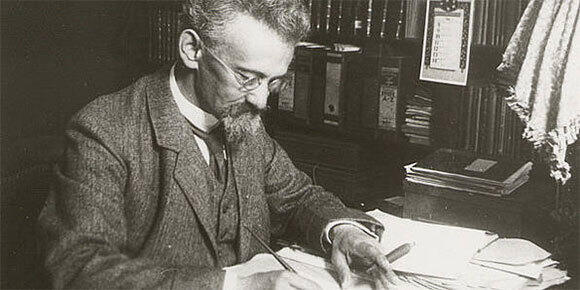

Difficult to surpass the clearness and precision of his book. Felix Hausdorff in his office
(Photo: Hausdorff Center for Mathematics, University of Bonn)
Spaces and Sets
The year 1914 marked the publication of Felix Hausdorff’s book ‘Grundzüge der Mengenlehre’ (Basics of Set Theory). This was the first textbook that addressed all aspects of this subject, presenting full and clear proofs for its concepts. Special attention was given to the chapter about sets of points, which introduced tools for handling collections of points that create mathematical spaces.
This was an important milestone in the development of the emerging field of topology, a mathematical field concerned with the study of the properties of space. Topology today is an integral part of many branches of mathematics, and the foundations laid by Hausdorff in his book and articles are the primary basis upon which the field was built and developed.
The book included many more breakthroughs, among them in measure theory, which deals with ways to measure or estimate the size of sets. Hausdorff developed tools for measuring the volume of complex shapes, and also found unique connections between measure theory and probability theory.
Another significant contribution of his is the “Hausdorff maximal principle” - an important tool for dealing with partially ordered sets, which allows for the demonstration of the existence of a certain mathematical object without having to construct it. This is the basis for what is known today as Zorn’s Lemma, which makes a more extensive use of a similar principle. The book also presented the Hausdorff paradox, now more widely known as the development derived from it, the Banach-Tarski Paradox, which states that one can break down a sphere and use the products to make two identical copies of the original sphere.
The book about set theory was published a few months before the outbreak of World War I. The war had a tremendous impact on everything happening in Europe, mathematics and basic science were sidelined in favor of scientific developments of military importance.
After the war, with the reemergence of civil science, interest in Hausdorff’s innovations surged and his works were extensively cited in articles and books, especially in new journals that specialized in topology and set theory. Due to high demand, the book on set theory was republished in multiple editions. “It would be difficult to name a volume in any field of mathematics, even in the unclouded domain of number theory, that surpasses the Grundzüge in clearness and precision” wrote American mathematician Henry Blumberg in 1921.
Hausdorff was 46 when the war broke out, and was not drafted, allowing him to continue his mathematical work with great vigor during this period. One of the more interesting products from this period is the definition of the Hausdorff dimension, which is used to define certain topological spaces, and it plays an important role in the definition and understanding of fractals - geometrical structures where each part is a miniature copy of the entire shape. Fractals have great importance in nature and mathematics, and Hausdorff’s foundational paper on this subject, published in 1919, was amongst the most cited mathematical articles of the 1920’s.
7 View gallery


Multiple contributions to mathematics, alongside intellectual wealth in other fields. Hausdorff wrote under his own name and under the pen name Paul Mongré
(Photo: Paul Mongre)
Late to Notice
While Hausdorff distanced himself from political activity over the years, following World War I, he joined the German Democratic Party - a left-wing party that attracted Jewish politicians and intellectuals, including Albert Einstein. However the party’s popularity rapidly declined and Hausdorff, who was never an active member, canceled his membership in the mid-1920’s.
Shortly after the rise of the Nazis to power in 1933 the ‘Law for the Restoration of the Professional Civil Service’ came into effect. This law turned antisemitism into a declared official policy and enabled the dismissal of Jews from their positions in public service, including academy researchers. Fortunately for Hausdorff, the law did not apply to him as he had been in public service before 1914. He kept his position, but definitely felt the shift in atmosphere and was forced to discontinue courses and lectures due to the activities of Nazi students at the university.
In 1935, when he was 66 years old, Hausdorff was abruptly forced into retirement. He was dismissed without any ceremony or acknowledgment of his 40 years of service in the German higher education system or his enormous contribution to mathematics. Nonetheless, he continued to work from his home, published another upgraded and updated edition of his book on set theory, and until 1938 he published seven more articles in the fields of topology and set theory, which appeared in Polish journals.
Hausdorff was able to stay current with developments in mathematics through his friend, mathematician Erich Bessel-Hagen, who was thirty years his junior. Bessel-Hagen was the only one among Hausdorff's friends who visited him regularly, and even borrowed books and journals from the university library for him, as Hausdorff, being Jewish, was no longer allowed entry. Despite the difficult circumstances, it seemed that Hausdorff was reluctant to leave Germany.
Like many others, it seemed that he had found it difficult to believe that the situation could deteriorate further, and even wrote that he did not believe that the Nazis would harm the elderly. His perspective changed following 'Kristallnacht' (Night of Broken Glass) in November, 1938, and he began seeking help from friends in hopes of obtaining a research grant that would allow him to leave Germany. Well-known mathematicians who had already left Germany, including Herman Weyl and John von Neumann tried to help him, but without success.
7 View gallery
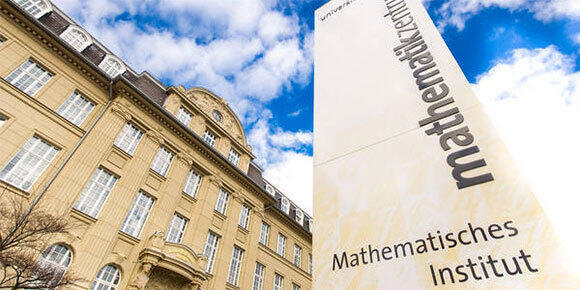

A late commemoration. The Hausdorff Center for Mathematics, founded at the University of Bonn in 2006
(Photo: Hausdorff Center for Mathematics, University of Bonn)
A Sad Ending
The situation in Germany became increasingly worse, particularly after the outbreak of World War II in 1939. During 1941, the Nazi regime began to gather Germany’s Jews and send them to extermination camps in Poland. The Jews of Bonn were ordered to report to the Endenich monastery, located west of the city, which has been converted into a concentration camp.
While some Jews still hoped for the best, Hausdorff had no illusions. When he received the order to report there in January 1942, he sat down to write his last letter to his friend, Jewish lawyer Hans Wollstein. After thanking his friends, he detailed his requested funeral arrangements, apologized to Wollstein for the inconvenience he was causing, and expressed hopes for better times for him and all their mutual friends.
After sending the letter, Hausdorff, his wife and her sister Edith Pappenheim, who lived with them, committed suicide by overdosing with sleeping pills. In accordance with his request to his friend Wollstein, they were buried in the Bonn cemetery. However, Hausdorff’s last wish for better times for Wollstein and their mutual friends did not materialize. The lawyer was murdered at Auschwitz shortly afterward.
Sadly, there are no known descendants of Hausdorff family. Both of Housdorff’s younger sisters, Valery and Martha, lived in Prague before the war, and it appears that they were murdered in the camps alongside their families.
Hausdorff’s daughter, Lenore, married the astronomer Arthur König, from Heidelberg. They had two sons, Felix (born in 1927) and Herman (born in 1929). The family survived the holocaust. Arthur passed away in 1969 and Lenore died in 1991. Felix and his wife, who were childless, died in a car accident in 1973. Herman, who suffered from a metabolic disorder resulting in mental disability, spent most of his life in medical care institutions. His death in 2010 marked the end of the Hausdorff family line.
7 View gallery
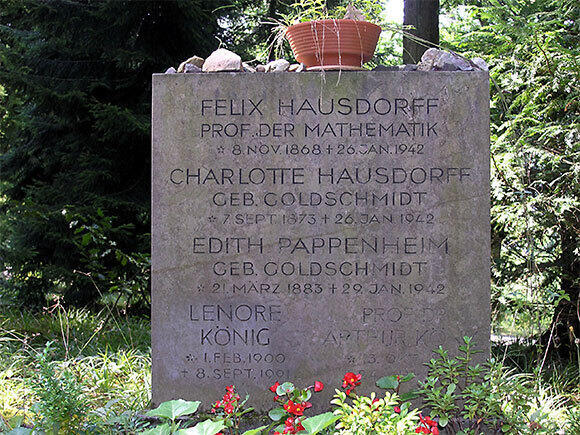

A dynasty with no continuation. The tombstone of Felix Hausdorff, his wife and sister-in-law at the Bonn cemetery. Their daughter and her husband were later interred with them
(Photo: Wikipedia)
Following Hausdorff’s death, his son-in-law, König, sold his library. Many of Hausdorff’s writings, which were incomplete, remained in his house and were preserved by the Egyptologist Hans Bonnet, a family friend. Unfortunately, Bonnet’s house was destroyed in a bombing in 1944 and the ruins were looted. The mathematical records were not of particular interest to the looters, and eventually Bonnet managed to salvage most of the materials.
Mathematician Gunther Bergamann spent many hours sorting and organizing the roughly 26,000 surviving pages and published some of the items. In 1980 he transferred these materials to the University of Bonn, where the Hausdorff Center for Mathematics was founded in 2006, dedicated to current research and to preserving the legacy of the esteemed mathematician.
At the University of Greifswald, where Hausdorff worked for several periods alongside his work in Bonn, there is a conference center and a guest house for scientists named after him, as well as a Felix Hausdorff street. The street where he lived at Bonn, which was originally named Friedrichstrasse, is now Hausdorffstrasse. Also in Leipzig, which he left due to antisemitism, a street, Felix Hausdorff road, has been named after him. An asteroid discovered in 1997 was also named in his honor.
However, the most enduring commemoration lies within mathematics itself: Hausdorff space, Hausdorf dimension, Hausdorff measure, and Hausdorff maximal principle are a small part of a long list of concepts named after him. These terms illustrate Hausdorff’s central role in the development of modern mathematics, and also the complete disregard by Nazi Germany for Jewish scientists and their substantial contributions to all fields of science - a disregard that ultimately contributed to the downfall of the Third Reich.

